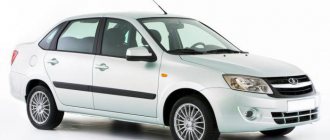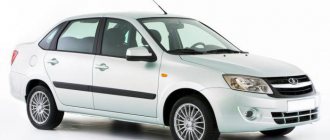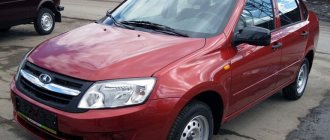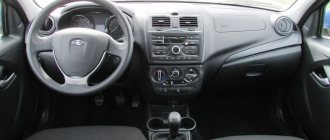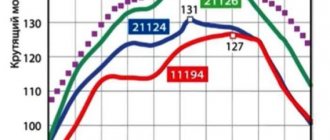VAZ-21104 is a car that literally changed the direction of Russian industry. It's no secret that for a long time domestic cars were among the worst in the world, however, now the situation has changed radically. If we take into account only the models that were developed for the domestic market, then they are ideal for driving even on Russian roads. They are produced fully adapted to the terrible conditions of our trails.
VAZ-21104
Experts from the company suggested installing “humpbacked” camshafts for testing - with modified valve timing. They recommended the so-called low-end ones, which improve engine performance in the most popular range for everyday use. At the same time, we optimized the ECU firmware - and the previous lethargy at the lower levels disappeared. Even with a heavy trailer you can move confidently in heavy traffic. And on a suburban highway, when starting to overtake, you have to shift down much less often.
We were not interested in how much the maximum speed of the car had changed. But the average fuel consumption has not increased, and, according to a rough estimate, has even fallen slightly and does not go beyond 7.5 l/100 km. With new shafts, the engine has already covered 140,000 km and still works flawlessly.
The first clutch lasted surprisingly long. Despite frequent strength exercises, it lasted almost 90,000 km. Now the second set costs 3150 rubles.
Family cars
VAZ-2110 (LADA 110)
Four-door front-wheel drive sedan. Produced at AvtoVAZ from 1995 to 2007.
The first VAZ-2110s were produced on June 27, 1995 in AvtoVAZ pilot production, mass production began in August 1996, sales began in November of the same year [5]. By that time, technology in the global automotive industry had reached a new level, and the breakthrough model for the late 80s could no longer be called an absolute novelty. However, despite this, as well as some complaints about the quality of production in the 90s, it still became a step forward for the domestic automobile industry. Unlike the Lada and Samara, the VAZ-2110 was positioned as a higher-class car, quite modern and competitive both externally and internally. In particular, an electronic engine control system was installed on the car (although the first VAZ-2110s were carburetor) and a diagnostic unit (on-board computer), it was possible to install power steering and electric windows, galvanized metal was used in body parts, and a new painting technology was used bodies, etc. The appearance of the “ten” marked a new stage in the development of the domestic automobile industry.
In March 2007, on the main assembly line of AvtoVAZ, serial production of cars of the new LADA Priora family was launched, which was a deep restyling of the “tens” and designed to replace the last one in the model range, and the “tens” were produced in parallel. The last set of VAZ-2110 was assembled on the Togliatti assembly line on October 15, 2007. VAZ-2111 (station wagon) and VAZ-2112 (hatchback) were produced for another two years and a year, respectively.
Until 2014, VAZ-2110s were assembled under license from AvtoVAZ vehicle kits at the Bogdan Corporation automobile plant in the Ukrainian city of Cherkassy under the Bogdan brand. A pickup truck based on the VAZ-2110 was also developed [6].
In arctic conditions, a simple crane from model 2108 is more reliable.
In arctic conditions, a simple crane from model 2108 is more reliable.
In arctic conditions, a simple crane from model 2108 is more reliable.
For many people, shock absorbers work, as they say, until the bitter end - until they completely leak. Of course, you shouldn't wait for this. Body sway and loss of trajectory stability already by 60,000 km (a very worthy resource!) became quite noticeable, and we replaced the shock absorbers. Instead, they supplied SS20 products from System of Technologies. These, working to this day, do not knock, do not leak, and with them the car holds the road well.
The battery, after serving for three years, stopped accepting a charge. The reason is simple: the charging voltage is low - about 13.9 V, and even less when the headlights are on. The battery, remaining undercharged, quickly sulfates, and it is not always possible to “boost” it to its nominal capacity. Therefore, having bought a new one, we built a diode into the voltage regulator circuit, raising the voltage to 14.5 V. Since then, the battery has served faithfully.
Once, while traveling in the winter Arctic, the climate control failed - the heater damper drive burned out. There are no spare parts, and in the cold you can’t do much without a stove. We had to look for a solution. First of all, we forcibly opened and locked the damper. Heat entered the cabin, and its excess was dumped out the open window. The next day, the mechanics of an unknown service station cut a tap from a G8 into the heater hose, and its drive—a choke cable from a Lada—was brought into the cabin under the steering column.
Dimensions and features of modification 21102
Let's look at the technical characteristics of the VAZ 21102: overall dimensions, engine, transmission, suspension. Let's start with the dimensions.
| Aspects | Indicators |
| Length | 4.265 m |
| Width | 1.676 m |
| Height | 1.42 m |
| Wheelbase length | 2,492 m |
| Front track width | 1.41 m |
| Rear track | 1.38 m |
| Clearance | 16.5 cm |
The body type of the car 1102, like the entire line, is a sedan. The car is front-wheel drive, has 4 doors and 5 seats. The luggage compartment volume is 430 liters. The fuel tank holds 43 liters of gasoline. The curb weight is 1020 kg, and the total weight is 1495 kg.
Modification 21102 is the second oldest among all the “ten”. The opinion that this version is a successor to car 21101 is erroneous. In 1996, AvtoVAZ launched the first model of the VAZ 2110 into mass production. The pilot version of the “ten” was experimentally equipped with a carburetor fuel supply system. But a few months later, the company's leading engineers introduced a new version of Lada. It was decided that a modern car, which is the Lada 110, should have the injection principle of gasoline injection.
In the same 1996, an engine with an injector was introduced into the next version of the Lada - 21102. However, the number of valves was not increased from 8 to 16. This modernization “overtook” only the VAZ 21103 in 1997. But model 21101 is the youngest of the entire line. The version went on sale in 2004. It is a copy of the first “ten”, but has undergone restyling and modifications to the engine.
In the case of the VAZ 21101, repairs are less urgent, because the car is newer than 21102.
Northern version of heater control. View from the salon.
Northern version of heater control.
View from the salon. Northern version of heater control. View from the salon.
The solution turned out to be so simple and successful that later the damper control was restored in the same way. Not electronics, of course, but trouble-free and even duplicated - you can control the tap, or you can control the damper! And we don’t even remember the imaginary loss of comfort - the controls are supposedly now manual.
The latest improvements include small side headlights to shine on the roadside when turning. They turn on automatically when you turn the steering wheel. An extremely convenient thing when maneuvering in the dark! And the last major expense was replacing the driver’s seat for 3,500 rubles. The old one had sat down to the frame, the foam rubber had decayed - and no amount of plywood could return it to its original shape.
Of course, we constantly monitored tires, brakes, etc. Consumables, of course, cost money, but safety is more expensive. However, operation did not cost 5–6 rubles per kilometer, but three times cheaper.
Final table (click to open full size):
VAZ-21124
Engine. He incomprehensibly “troubled”, jerking the car even while moving. One by one they changed the spark plugs, ignition coils, phase sensor and mass air flow sensor... In addition, the antifreeze was going somewhere, when braking the car pulled to the side, the rear wheel bearings made an ominous noise, the standard electric door locks did not work...
I could go on and on about the defective list for a long time, but I’ll just say that the next 30,000 km came with a lot of blood. Of course, spare parts are not the most expensive, but over time a considerable amount accrues.
Safety
The Russian VAZ-2110 car was also crash tested. The result of the checks carried out in Togliatti turned out to be quite good, when compared with Volga, which, out of the available 16 points, was able to get only a meager 2.
After the frontal impact, the front driver's door was in place, and there was not even a single crease on it, and the windshield pillar was only slightly bent. However, the front door did not open due to the fact that she had propped the back door open. This is not a hopeless option, because it is possible to leave the car using the right door.
But what happens to the mannequins? The sensors that were installed on them did not show any life-threatening overloads! Despite the fact that the driver roughly hit the steering wheel and the dashboard, and the passenger sitting next to him hit the front panel, the head injury rate does not exceed the safe limit - 650 units.
This makes it possible to conclude that the probability of getting a head injury in people who are wearing a seat belt is less than 5%. The important advantages of the sedan were confirmed - the strong power structure of the interior. The conclusion is the following - before soft-boiled, but the interior is intact. This was achieved thanks to safety bars that were welded into the front doors. The material of the beams is not light planks, but steel pipes.
The seat slides were also able to withstand the collision, again not on their own, but thanks to the modernized profiles of the retainer teeth. A small load when the dummy's head collides with the steering wheel was achieved because VAZ made it injury-proof.
The corners of the visor were rounded, and the front panel was made of soft plastic. But there were obvious large overloads on the chest from the seat belts, so the calibrated spring was compressed by 0.40 cm, and in the chest of the passenger sitting next to it by 0.45 cm.
This is partly due to the lack of an airbag, which would soften the result of a sudden and rough stop of the car. So, the load exceeds 800 kg.
On the 10, the steering wheel was shifted slightly back and up (0.95 and 0.45 cm, respectively). Moreover, the steering wheel moved to the right by 1.10 cm, and this is already exceeding the qualifying EuroCAP lateral movement limit.
Regarding the legs, there is a great danger of damaging them. For example, the right leg bears an impact of 730 kilograms. Even the pedals exceeded the permissible threshold - they went back by 205 mm, and according to European standards, a pedal offset of more than 200 mm is already a critical indicator.
Based on the results of calculations and summing up the results, the VAZ-2110 scored 4 points, which is twice as high as the Volga 3110, and the same as Svyatogor. If we talk about what the top ten lacks, these are modern seat belts, airbags, body modifications, changes to the lower part of the front panel and other pedals.
Crash test
Modifications
- VAZ-21100 - eight-valve carburetor, the volume of which is 1.5 liters (produced from 1996-2000);
- VAZ-21101 - eight-valve, the volume of which is 1.6 liters;
- VAZ-21102 – eight-valve, volume 1.5 liters;
- VAZ-21103 – sixteen-valve engine, the volume of which is 1.5 liters;
- VAZ-21104 - sixteen-valve power unit, volume 1.6 liters;
- VAZ-21106 – Engine from Opel GTI 2.0 16V – 2.0-liter sixteen-valve engine, developing 150 horsepower and capable of reaching a top speed of 205 km/h. The VAZ 21106 reaches the initial hundred kilometers per hour in 9.5 seconds;
- VAZ-21106s – created on the VAZ-21106 platform. The technical details are the same as for the VAZ 21106. It has the following modification: power steering, a unique interior, an electric sunroof, fog lights and a disc brake system, which was installed not only on the front wheels, but also on the rear;
- VAZ-21107 is a car with a sixteen-valve two-liter Opel engine, which is designed on the 21106 platform. This model was tuned for a sporty driving style, championships and rallies;
- VAZ-21108 - “Premier” - a version of the Russian sedan, which was slightly lengthened;
- VAZ-21103;
- VAZ-21109 – “Consul” is a four-seater limousine with an engine capacity of 1.5 liters. It reaches 5 meters in length;
- VAZ-2110-91 – “Rotor-Sport”. Production started in 1996 and ended in 2004. A 1.3-liter rotary piston power unit was used. This type of car is the fastest among its “family”. The maximum speed reaches 240 km/h. Reaches the first hundred in just 6 seconds. The car is tuned for circuit racing.
Alas, perpetual bearings were never invented...
Alas, eternal bearings were never invented...
Alas, eternal bearings were never invented...
Take a look at the expenses table! They could have been even larger, but we, without expecting it ourselves, saved money by testing certain components on the car. When the first set of shock absorbers had almost served their purpose, it was replaced by the Acomi set. Later, their place was taken by SS20 products. Here the matter was not limited to simply installing shock absorbers: the company offered to equip the car with a kit with damping adjustment depending on the condition of the road. The interesting results of these tests are described in ZR, 2010, No. 12. Naturally, these experiments are not reflected in the cost table.
But the front seats were perfectly preserved after 160,000 km! It’s not about their outstanding durability, it’s just that up to 100,000 km they, carefully packed in polyethylene, lay in a warehouse, and sports tires worked in tire tests.
Exterior
At the time of its release, the VAZ-2110 had a modern look, but at the same time, it became the subject of criticism and discussion among automotive experts. Many people think, looking at some elements, that the design of the car is unattractive. The most problematic area of the design is the rear wing.
The rear of the VAZ, when viewed in profile, seems too heavy. Although, if we compare it with the VAZ 21099, the new model has noticeably improved aerodynamic performance. And as a result of fairly good streamlining, the new VAZ-2110 has become more economical. There are no rectangular shapes here, like on the Samara, and overall the car looks neat.
Now bumpers began to be painted in body color, even in the cheapest modifications. This gave it a characteristic look, especially in those days when it was not always possible to find something like this even in foreign cars. And the most expensive modification - luxury, had additional headlights on the front bumper, and an additional stop light behind the rear window.
All body parts subject to corrosion are galvanized. The body part of the 10th Lada is made more than half of galvanized steel, which in itself increases anti-corrosion resistance.
However, even when purchasing a galvanized VAZ model, you won’t have to rest on your laurels, because those who did not do the anti-corrosion treatment could notice rust on the bottom of the car. Therefore, there is only one conclusion - anticorrosive should be done, regardless of galvanized steel.
Starting with the “norm” configuration, metallic paint is provided, and already in the “Lux” version the VAZ-2110 comes with fourteen-inch alloy wheels. Thanks to the glued glass, body rigidity increases, which is undoubtedly a plus, however, the gaps between body panels in some places can reach 7 millimeters.
If we talk about the door handles, they are made for a lower grip, and this in turn indicates that the vehicle was developed a long time ago. The lock cylinder, which is mounted separately from the handle itself, indicates that the Volzhsky Automobile Plant sedan is budget-friendly.
The appearance of the new model was clearly different from the already familiar “chisel shape” of the cars produced by the Volzhsky Automobile Plant. By reducing the drag coefficient, it was possible to reduce fuel consumption.
The dimensions of the car have become larger in length, height and width, and the track has also been increased along with the base. There was also an increase in mass. Speaking of the latter, it is worth noting that the increase in weight allowed the “ten” to look more respectable, which raised it half a step higher in the table of ranks.
Because of this, changes had to be made to the “running”, although the most important decisions were left the same. Looking at its appearance, you notice that the “brainchild” of domestic automobile production has become heavier and duller. Although, if you evaluate each element, then everything is at its own level.
There are licked surfaces, powerful bumpers painted in body color, and a cute, albeit overly plump, “butt.” However, if you put all this together, then for unknown reasons it does not add up. The characteristic “chisel” grin that was on previous VAZ models is, fortunately, not to be found here.
The front glass of the car is glued in, which indicates the absence of a standard seal. The windshield wiper arm now has an aerodynamic clamp. If we talk about the luggage compartment (which includes the VAZ 2111), the opening has become wider and the loading height has become lower.
Heater radiator - change! The steam outlet fitting is broken.
Heater radiator - change!
The steam outlet fitting is broken. Heater radiator - change! The steam outlet fitting is broken.
By the end of the reporting period, the trunk floor presented a problem: its plastic base crumbled into fragments, the carpet turned into a shapeless rag. Based on the prints on the rug, we cut out 5 mm thick hardboard panels and glued them to the upholstery with “liquid nails” - it turned out they didn’t hold! I had to put him on wire braces. The decision was completely justified.
Each kilometer of our “two-wheeler” cost 2.23 rubles. We think it’s acceptable, and in general we’re happy with the car. Although, of course, it’s a pity that the energy and time wasted on numerous repairs.
Final table (click to open full size):
Lada 110 photos
Read further:
Amazing hatchback Lada X-Ray Cross: price and specifications in Russia
The interior of the Lada Vesta is not impressive
Porsche 928
Dodge Viper ACR
Buick Electra 225 Convertible
Our VAZ -21104 is a real hard worker. How many events did it participate in, how much cargo was transported on it!
VAZ-21104, VAZ-21124: outgoing family
Engine problems
VAZ-21104 has some problems with the propulsion system. The most common problem that most drivers encounter is overheating of the unit. This is due to poor performance of the ventilation system. A sensor malfunction is a factory error. It lies in the fact that the wires connected to it must interconnect and be in a closed system. If their position is not controlled, the engine can heat up by more than 95°. It is best to take the car to a service station and have the part replaced. If this is not possible, then you should correct the position of the wires with your own hands and monitor how hot the engine is. Accordingly, you can’t go on long trips with such a problem.
Sometimes the cause of overheating may not be the sensor, but the presence of a so-called air lock. Its location is the radiator. In order to get rid of the problem, you should press the upper pipe several times. Under no circumstances should engine overheating be ignored, because it can be fatal.
